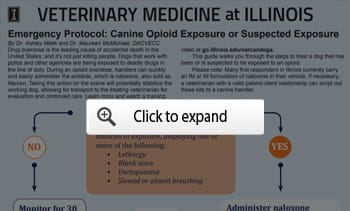Stern Warning to All Pet Parents Who Walk Their Dogs Just About Anywhere
If not for the fast action of this man and his astute veterinarian, his 3-month-old puppy would've died. Her breathing slowed, her tongue hung from her mouth, and her eyes rolled back in her head. There's been a big uptick in these cases, almost unheard of just a few years ago.

STORY AT-A-GLANCE
- The opioid epidemic is far-reaching and is now touching the lives of dogs and their owners
- Police dogs are the most common canine victims of overdose thanks to the type of work they do and the dangers associated with exposure to very powerful opioids like fentanyl
- First responders are now learning how to administer naloxone (a drug that reverses the effects of opioids) to dogs as well as humans
- Family dogs are also increasingly being exposed to opioids, so it’s very important to secure all drugs in your home and take care not to let your pet lick or pick up objects she finds outdoors
Editor's Note: This article is a reprint. It was originally published March 21, 2018.
The opioid crisis in the U.S. is in the news every day it seems, and with good reason. Deaths from opioid overdoses are now the leading cause of death in Americans under 50.1 What many people don't realize, however, is this deadly epidemic is also causing overdoses in dogs, especially working dogs who encounter drugs in the line of duty. According to the American Veterinary Medical Association (AVMA):
"Emerging opioids like fentanyl and carfentanil are so potent that even a small exposure can be deadly. To combat these drugs, many law enforcement officers have begun carrying naloxone, sometimes sold under the brand name Narcan, which can reverse the effects of a drug overdose.
In the right hands, this drug can be used effectively to provide emergency treatment for working dogs, but the version carried by law enforcement officials is often a nasal spray rather than the injectable version commonly used by veterinarians."2
Naloxone, which comes as either an intranasal spray or an injection, reverses the effects of all types of opioids, including heroin, morphine and the incredibly dangerous fentanyl (50 times more potent than heroin) and carfentanil (10,000 times more potent than heroin).
Now Available: Training in How to Use Narcan to Reverse Canine Opioid Overdose
Getting a dog who has been exposed to opioids to a veterinary clinic in time to save him isn't always possible. Research shows that proactive administration of naloxone on the scene has life-saving potential, however, while most first responders (police officers, firefighters, paramedics) carry naloxone in their vehicles for use in human overdoses, canine officers have little or no experience using it in dogs.
Fortunately, a group of interested parties including the AVMA, the University of Illinois College of Veterinary Medicine and the Police Training Institute has addressed the problem with a training video on reversing opioid overdoses in dogs:
Illinois VetMed also created a step-by-step flowchart that includes the signs to watch for in a dog who may have been exposed to opioids:

3-Month-Old Labrador Puppy Overdoses on Her Morning Walk
If you're thinking that since your canine companion isn't a police dog, and since no one in your family is among the 33% of adults prescribed opioids in the U.S.,3 you have no reason to be concerned about an overdose in your pet — you might want to rethink. According to the Boston Globe, a dog owner in Massachusetts was walking his 3-month-old yellow Lab puppy, Zoey, in his Andover neighborhood. Andover is a picturesque town known for its excellent schools and low crime rate.
While walking, Zoey came across a discarded pack of cigarettes on the ground and began investigating, as puppies do. Her owner, Peter Thibault, pulled the pack from her mouth, planning to retrieve it on their way back. Two very short minutes later, the puppy dropped to the ground, motionless. Thibault hurried back home with Zoey, and watched in horror as her breathing grew labored, her tongue hung out of her mouth and her eyes rolled back in her head.
Panicked, Thibault rushed Zoey's limp body to a veterinary clinic in North Andover. "They asked what happened, and when I explained how the morning went, they fixated on the cigarettes, but I wasn't sure why," Thibault told the Globe.4 Fortunately, veterinarian Kristine Demers knew there were a very limited number of causes for a sudden collapse in an otherwise healthy puppy who had just chewed something she found on the street, and immediately suspected an opioid overdose.
She administered naloxone to Zoey, and five minutes later when Thibault was called back into the exam room, he found his puppy "up and at 'em like nothing had happened." Zoey stayed with Demers for another 12 hours for observation, was released and is expected to make a full recovery.
A Wake-Up Call for All Pet Parents and Veterinarians
Zoey's overdose was caused by licking drug residue (probably fentanyl) from the cigarette pack. But for the fast action of Thibault and quick thinking by Demers, Zoey's opioid overdose would very likely have been fatal.
The frightening incident was a wake-up call for Thibault and his wife, who moved from Boston to Andover to raise their children in a safe community, away from high-crime metro areas. "That corner where the dog ingested the opioids is where I drop my kids off in the morning," he told the Globe. "It's their bus stop. It's very troubling. What if one of the kids had picked it up?"
The veterinary clinic where Demers practices has seen an increase in opioid overdose cases, which were almost unheard of just a few years ago. Zoey's story should serve as a warning to all pet parents who walk their dogs around the neighborhood. Be very careful not to let furry family members lick or mouth or swallow objects they find on the ground. Also insure all drugs in your home are in closed containers (not baggies) and secured in cabinets or closets.
Unfortunately, when Thibault returned to the spot where Zoey found the cigarette pack, it was gone. Let's hope it wasn't picked up and carried off by another animal or a child.











